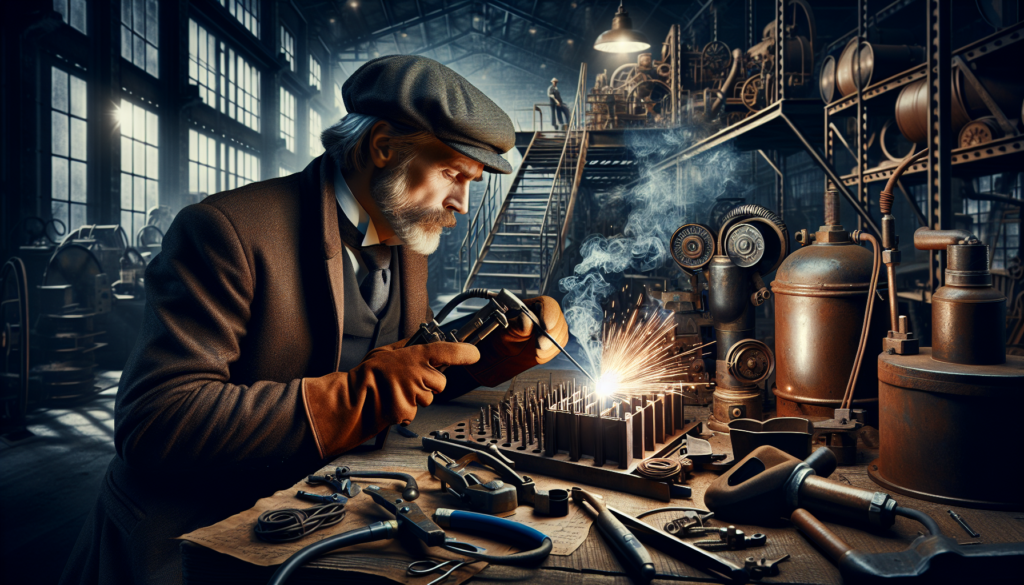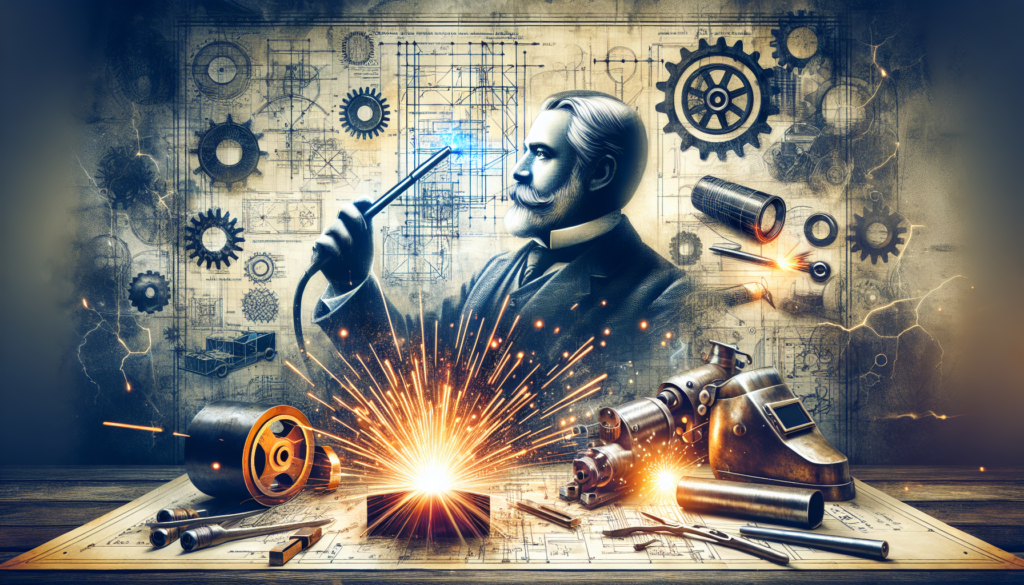Imagine a world without the amazing inventions and advancements that have shaped our lives. Now, picture a dedicated individual who has not only revolutionized an industry but also transformed the way we build and create. This is the story of the Welding Inventor, a trailblazer who has single-handedly propelled the field of welding into a new era of innovation and efficiency. Through their ingenuity and tireless dedication, the Welding Inventor has left an indelible mark on the world, forever changing the way we connect and construct.

Early Origins of Welding
Ancient Welding Techniques
Welding, as a technique of joining metals, has been around for centuries. In ancient times, people used different techniques to fuse metals together. One such technique was forge welding, where metals were heated and hammered to form a solid bond. Another method was known as pressure welding, where metals were compressed and formed a bond under immense pressure. These ancient welding techniques laid the foundation for the advancements that followed.
Medieval Welding Innovations
During the medieval period, new welding techniques and innovations emerged. One of the notable advancements was the use of blacksmiths’ techniques, such as using heat and pressure, to join metals together. Additionally, the discovery of flux, a substance used to prevent oxidation during welding, revolutionized the welding process. These medieval welding innovations set the stage for the modern welding techniques that we use today.
Beginnings of Modern Welding
Invention of the Arc Welding Process
The invention of the arc welding process in the late 19th century marked a major milestone in the history of welding. It was Sir Humphry Davy who first demonstrated the concept of arc welding by using a battery and carbon electrode to create an electric arc. However, it was not until the early 20th century that the arc welding process became more practical with the introduction of coated electrodes. This breakthrough allowed for more effective welding and laid the groundwork for further advancements in the field.
Pioneers in Resistance Welding
Resistance welding, another significant form of modern welding, was pioneered by Elihu Thomson and Thomas Edison in the late 19th and early 20th centuries. This process involves fusing metals by applying pressure and passing an electric current through the junction. Thomson and Edison’s contributions to resistance welding played a vital role in the development of welding technology and made it possible to join metals efficiently and quickly.
Development of Gas Welding
The Role of Carl Wilhelm Siemens
Carl Wilhelm Siemens played a crucial role in the development of gas welding. In the 19th century, Siemens discovered that a flame produced by burning coal gas could be used to weld metal plates together. His experiments and innovations in gas welding laid the foundation for the future advancements in this welding technique.
The Oxyacetylene Welding Torch
The oxyacetylene welding torch, invented by Edmond Fouché and Charles Picard in the late 19th century, revolutionized the gas welding process. This torch utilized a mixture of acetylene gas and oxygen to produce a high-temperature flame suitable for welding metals. The oxyacetylene welding torch became widely adopted and remains an important tool in many welding applications to this day.
The Welding Revolution
Advancements in Electrode Development
Advancements in electrode development in the early 20th century proved to be a game-changer for welding. The introduction of coated electrodes, where a flux coating was applied to the electrode, allowed for greater control and efficiency in the welding process. Coated electrodes reduced oxidation, created a more stable arc, and improved the overall quality of the weld. These developments led to a significant leap forward in welding technology and paved the way for further innovations.
Introduction of Submerged Arc Welding
Submerged arc welding, introduced in the 1930s, revolutionized the welding industry. This technique involved feeding a consumable electrode into a weld pool while the area was covered in a powdered flux. The flux protected the weld from contamination, and the process allowed for high deposition rates. Submerged arc welding became widely adopted in industries such as shipbuilding and construction, making large-scale welding projects more efficient and cost-effective.

Welding in the Industrial Age
Automated Welding Techniques
As industries grew in the industrial age, the demand for increased welding productivity led to the development of automated welding techniques. One of the notable advancements was the introduction of automatic welding machines, which could perform repetitive welding tasks with precision and speed. These machines increased productivity, reduced labor costs, and made welding more accessible to industries of all sizes.
Welding in the Automobile Industry
The rise of the automobile industry in the 20th century created a significant demand for efficient welding techniques. The introduction of spot welding, a process where two metal sheets are fused together using localized heat and pressure, transformed the way automobiles were manufactured. Spot welding offered high-speed production capabilities without the need for additional filler materials, making it ideal for automotive assembly lines. The adoption of spot welding revolutionized the automobile industry and made mass production more efficient.
Invention of the Welding Helmet
The Creation of the First Welding Shield
The invention of the welding helmet brought about a revolution in welder safety. The first welding shield, created by a Chicago-based inventor named A.P. Hood in 1914, aimed to protect the welder’s eyes and face from the intense light emitted during the welding process. This invention allowed welders to work longer without damaging their vision and greatly enhanced their overall safety.
Improvements in Safety and Protection
Over the years, welding helmets have undergone numerous improvements to enhance the safety and protection of welders. Today, modern welding helmets are equipped with auto-darkening filters, which automatically adjust the shade of the lens to protect the welder’s eyes from harmful ultraviolet and infrared rays. In addition to eye protection, modern helmets also provide shielding against sparks, debris, and other hazards, ensuring the welder’s safety while working.
Exploration of Non-Fusion Welding
Innovations in Solid-State Welding
Solid-state welding techniques emerged as an alternative to fusion welding methods, where metal is melted to form a bond. These innovative processes include friction welding, ultrasonic welding, and explosive welding, among others. Solid-state welding techniques offer advantages such as lower heat input, reduced distortion, and precise bonding. These advancements have expanded the range of materials and applications in which welding can be used.
Introduction of Laser and Electron Beam Welding
Laser and electron beam welding, introduced in the mid-20th century, brought new possibilities to the welding industry. These techniques utilize highly concentrated energy beams to melt and join metals together. Laser welding offers precision and speed, while electron beam welding provides deep penetration and excellent control. Both methods have found applications in industries such as aerospace, electronics, and medical manufacturing, where high-quality and intricate welds are required.
Robotics and Welding Automation
Evolution of Welding Robots
The integration of robotics into the welding process has transformed the industry by increasing efficiency and productivity. Initially, welding robots were introduced in the automotive industry to perform repetitive welding tasks, improving precision and reducing labor costs. Over time, welding robots have become more advanced and versatile, capable of handling complex welds with precision. The evolution of welding robots continues to shape the future of the welding industry, allowing for greater automation and increased productivity.
Integration of Artificial Intelligence in Welding
Artificial intelligence (AI) has also made its way into the welding industry, further enhancing automation and productivity. AI algorithms can analyze data from sensors and cameras to make real-time adjustments in the welding process, ensuring optimal weld quality and reducing errors. The integration of AI technology in welding not only improves efficiency but also enables predictive maintenance, minimizing downtime and reducing costs associated with equipment failure.
Welding Inventors and Their Contributions
Nikolay Benardos – Inventor of Arc Welding
Nikolay Benardos, a Russian inventor, is credited with the invention of arc welding in 1881. His early experiments with carbon electrodes laid the foundation for the development of the arc welding process. Benardos’ invention revolutionized the welding industry and paved the way for modern welding techniques.
Benjamin Krasin – Pioneer of Resistance Welding
Benjamin Krasin, an American inventor, made significant contributions to resistance welding. In the late 19th century, Krasin developed a method of electrically joining metallic strips, which formed the basis for modern resistance welding techniques. His pioneering work played a vital role in advancing welding technology.
Edmund Davy – Innovator of Gas Welding
Edmund Davy, a British chemist, made groundbreaking discoveries in gas welding during the 19th century. His experiments with coal gas led to the discovery of its potential as a heat source for welding metals. Davy’s innovative work laid the groundwork for the development of gas welding techniques.
Patricia DiMichelo – Inventor of the Automatic Welding Helmet
Patricia DiMichelo, an American inventor, is credited with the invention of the automatic welding helmet. In 1981, DiMichelo patented a welding helmet with an auto-darkening filter that automatically adjusted the shade to protect the welder’s eyes. Her invention greatly improved safety and comfort for welders and has become a standard piece of equipment in the welding industry.
Future Prospects of Welding
Advancements in Welding Materials and Techniques
The future of welding holds great promise with advancements in welding materials and techniques. Lightweight and high-strength alloys are being developed, opening doors for new applications in industries such as aerospace and automotive. Moreover, advancements in additive manufacturing, commonly known as 3D printing, are revolutionizing the way components and structures are fabricated, offering unique possibilities for complex welds and customized designs.
Impact of Automation and AI on Welding Industry
Automation and AI technologies will continue to play a significant role in shaping the welding industry’s future. The integration of robotics and AI algorithms will further improve productivity, precision, and safety in welding operations. Additionally, predictive maintenance systems powered by AI will help minimize equipment downtime, ensuring uninterrupted production. As automation and AI become more prevalent, the welding industry stands to benefit from increased efficiency and higher-quality welds.
In conclusion, welding has come a long way since its early origins. From ancient techniques to modern innovations, welding has evolved and revolutionized numerous industries. The contributions of inventors and pioneers, along with the advancements in materials, techniques, and automation, have transformed welding into a highly efficient and essential process in today’s industrial landscape. With the continued advancements in technology, the future of welding looks promising, and the industry is poised to thrive in the ever-evolving world of manufacturing and construction.
